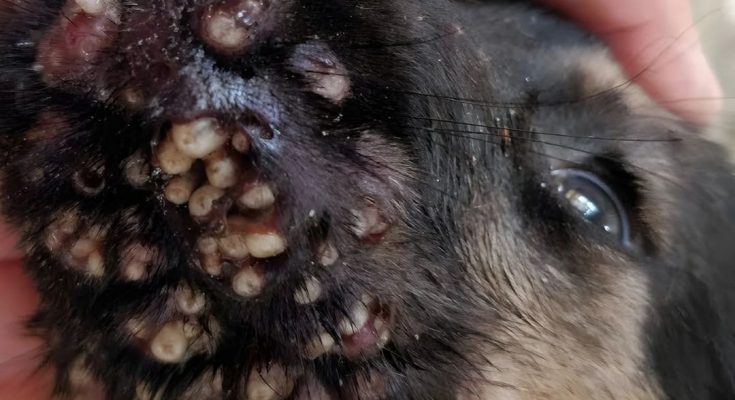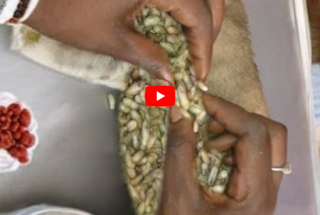Dogs, like all animals that spend time outdoors, are vulnerable to a variety of parasites and insects. One of the most disturbing and uncomfortable threats they face is the botfly, a parasitic insect whose larvae can infest a dog’s skin, creating painful swellings and potentially serious health problems. Although botfly infestations are more common in rural or wooded areas, any dog that spends time outside may encounter these pests. Understanding how botflies affect a dog’s life—physically, emotionally, and behaviorally—is important for pet owners who want to keep their companions safe and healthy.
Botflies are known scientifically as Cuterebra. Adult botflies do not bite or feed on animals; instead, they lay eggs near places where dogs often roam—such as grassy fields, burrows, or low shrubs. When a dog brushes against the area containing the eggs, the warmth of its body triggers the eggs to hatch. The newly hatched larvae then climb onto the dog’s skin and enter through natural openings like the nose or mouth, or through small cuts. Once inside, the larvae migrate under the skin and create a warble, a swelling with a small breathing hole through which the larva grows.
For the dog, this infestation can be both painful and confusing. A botfly larva under the skin often causes irritation, redness, swelling, and itching. Dogs may repeatedly lick or scratch the affected area, trying to relieve the discomfort. Some dogs become restless, irritable, or anxious because the sensation of something moving under their skin is extremely unsettling. In more severe cases, dogs may develop fever, lethargy, or loss of appetite. While the larva itself usually stays localized under the skin, complications like secondary infections can arise if the area is scratched excessively or becomes contaminated.
One of the most noticeable impacts of a botfly infestation on a dog’s life is the behavioral change that comes from pain and irritation. Dogs that were once active and playful may become withdrawn. They may avoid being touched, especially around the affected area, and may even become aggressive if the site is painful. Sleep patterns may also be disturbed because the irritation intensifies at night. These changes can strain the bond between the dog and the owner, who may not initially understand what is causing the distress.
However, botfly infestations do more than just cause discomfort—they can affect a dog’s overall health. While most botfly larvae settle underneath the skin, some may accidentally migrate to more sensitive areas such as the eyes, respiratory passages, or even the brain, though this is rare. These situations can lead to serious health complications, including breathing problems, vision issues, or neurological symptoms such as seizures or disorientation. Prompt detection and veterinary care are critical to prevent such risks.
Treatment of botfly larvae requires careful professional handling. It is extremely important not to squeeze or pull the larva out by force at home. Doing so can rupture the larva, releasing toxins that may cause a severe inflammatory reaction. A veterinarian typically removes the larva safely by enlarging the breathing hole or using tools to coax it out intact. Once removed, the dog may need antibiotics to prevent infection and medications to ease swelling and pain. Most dogs recover quickly after treatment, and the wound typically heals within a couple of weeks.
Emotionally, the recovery of a dog after a botfly infestation depends on how early the issue was noticed and treated. Dogs that endured prolonged discomfort may remain cautious for some time, especially when handled near the previous wound site. Gentle care, reassurance, and patience from the owner help the dog regain confidence. Many dogs return to their normal behavior shortly after healing, but the experience can still leave a lasting impression, especially in sensitive or anxious dogs.
Preventing botfly infestations is an essential part of maintaining a healthy life for dogs who spend time outdoors. Owners can reduce risk by keeping dogs away from rodent burrows, tall grasses, and overgrown vegetation, where botflies commonly lay their eggs. Grooming the dog regularly and inspecting its skin after outdoor activities can help detect any signs of swelling early. Keeping the yard clean and trimming bushes also discourages botflies and other parasites. In some regions, seasonal awareness is important because botflies tend to be more active during specific months.
A botfly infestation can disrupt a dog’s physical comfort, emotional well-being, and overall quality of life. The irritation caused by the larva, the pain from the swelling, and the stress of the experience all contribute to significant discomfort. However, with timely detection, proper veterinary treatment, and preventive care, dogs can fully recover and continue living healthy, happy lives. For dog owners, understanding this unusual but important threat is key to ensuring that their companions remain safe in the environments they love to explore.



